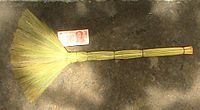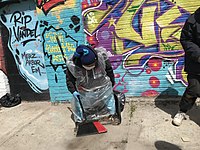Broom
A broom (also known as a broomstick) is a
A distinction is made between a "hard broom" and a "soft broom" and a spectrum in between. Soft brooms are used in some cultures chiefly for sweeping walls of cobwebs and
The broom is also a symbolic object associated with witchcraft and ceremonial magic.
Etymology
The word "broom" derives from the name of certain thorny
Flat brooms, made of
Manufacture

In 1797, the quality of brooms changed when Levi Dickenson, a farmer in Hadley, Massachusetts, made a broom for his wife, using the tassels of sorghum, a grain he was growing for the seeds. His wife spread good words around town, creating demand for Dickenson's sorghum brooms. The sorghum brooms held up well, but ultimately, like all brooms, fell apart. Dickenson subsequently invented a machine that would make better brooms, and faster than he could. In 1810, the foot treadle broom machine was invented. This machine played an integral part in the Industrial Revolution.[4]
United States
One source mentions that the United States had 303 broom factories by 1839 and that the number peaked at 1,039 in 1919. Most of these were in the Eastern United States; during the Great Depression in the 1930s, the number of factories declined to 320 in 1939.[5] The state of Oklahoma became a major center for broom production because broom corn grew especially well there, with The Oklahoma Broom Corn Company opening a factory in El Reno in 1906. Faced with competition from imported brooms and synthetic bristles, most of the factories closed by the 1960s.[5]
Magic
In the context of
In
In
This flight was also in Bedknobs and Broomsticks as well as Hocus Pocus.
In Eswatini (Swaziland), witches' broomsticks are short bundles of sticks tied together without a handle.[7]
Flying brooms play an important role in the fantasy world of
The Flying Broom (Turkish: Uçan Süpürge) is a feminist organization in Turkey, deliberately evoking the associations of a Flying Broom with witches.
In wider culture
- The Métis people of Canada have a broom dancing tradition. There are broom dancing exhibitions where people show off their broom dancing skills. The lively broom dance involves fast footwork and jumping.[8]
- "African-American wedding tradition that originated in marriages of slaves in the United States in the 19th century. Its revived popularity among African Americans is due to the 1976 novel Roots: The Saga of an American Family.[9] "Jumping the broom" was a marriage tradition in pre-Christian Britain and possibly through wider areas of Europe, such as Scandinavia and the Baltic Germanic tribes.[citation needed] Broom grows widely throughout Europe and Africa.
- During World War II, American submarine crews would tie a broom to their boat's conning tower when returning to port to indicate that they had "swept" the seas clean of enemy shipping.[10] The tradition has been devalued in recent years by submarine crews who fly a broom simply when returning from their boat's shake-down cruise. This tradition may stem from the action of the Dutch admiral Maarten Tromp who tied a broom to his main mast after defeating the British admiral Robert Blake at the Battle of Dungeness in 1652. This has often been interpreted as a message that he would "sweep the British from the seas". This story remains unsubstantiated,[11] but may have its origin in the tradition of hoisting a broom as a sign that a ship was for sale,[12] which seems more likely as Tromp had captured two of Blake's ships in the battle.[13]
- In Bhojpuri, it is called Baṛhanī (prosperer), as it is believed that it's prospers the family and house.[14]
Literature
- In 1701 Jonathan Swift wrote a "Meditation Upon a Broomstick", a parody of Robert Boyle's Occasional Reflections upon Several Subjects:
But a Broom-Stick, perhaps you will say, is an Emblem of a Tree standing on its Head; and pray what is Man, but a Topsy-turvey Creature, his Animal Faculties perpetually mounted on his Rational; His Head where his Heels should be, groveling on the Earth, and yet with all his Faults, he sets up to be an universal Reformer and Corrector of Abuses, a Remover of Grievances, rakes into every Sluts Corner of Nature, bringing hidden Corruptions to the Light, and raises a mighty Dust where there was none before, sharing deeply all the while, in the very same Pollutions he pretends to sweep away: His last Days are spent in Slavery to Women, and generally the least deserving; till worn to the Stumps, like his Brother Bezom, he is either kickt out of Doors, or made use of to kindle Flames, for others to warm themselves by.[15]
- In J.K. Rowling's Harry Potter novels and film adaptations, broomsticks are a common form of transport for wizards and witches. These are also used for the magical sport of Quidditch, in which players use their broomsticks to fly around a field and shoot goals.
Politics

For much of the 20th century, political cartoons and propaganda would often depict new or oncoming leaders sweeping away old, corrupt or unpopular figures.
The broom is used as a symbol of the following political parties:
- Aam Aadmi Party, India
- All Progressives Congress, Nigeria
Religion
- In Jainism, monks and nuns have a little broom with them, in order to gently brush aside ants and small animals, to avoid crushing them. This is part of observing the principle of Ahinsā.[16]
- The Shakers are often credited with the invention of the flat broom.
Sports
- Curling broom
- In home teamis close to accomplishing a sweep (having won the first two games of a three-game series or first three games of a four-game series), some fans will bring brooms to the ballpark and brandish them as a way of taunting the visiting team (examples: Arkansas vs. LSU, 2011; Red Sox vs. Yankees, May 13–15, 2011 and June 7–9, 2011).
- In broomball, broomsticks have their heads removed and are used to push a ball into a goal, on an ice surface. The game is similar to hockey, except players do not wear skates.
Image gallery
-
Common soft broom in Indonesia
-
Carved
-
A soft broom commonly used inHainan Province, China
-
Typical Filipino soft brooms (walís-tambô),Ifugao, Philippines
-
A hard-broom (walís-tingtíng) stall in the Philippines. Philippine hard brooms are often made from the hard primary veins of the leaves of the coconut palm frond.
-
A typical broom at a home in Haiti
-
A broom with bristles traditionally made usingbroom corn
-
A broom at a Rwandan home, made out of twigs
-
Two 'turkey tail' style brooms made from broom corn
-
Japanese warrior sweeping the deck with a broom before killing himself.
-
Floor broom
-
Street clean volunteer uses a broom, Earth Day 2021
-
broom made of the stem of coconut leaf
See also
References
- ISBN 978-0199206872.
- ^ "How to make a broom". Ogden Publications, Inc. Archived from the original on 2013-03-14. Retrieved 2010-03-15.
- ^ "Broom". Archived from the original on 2009-02-02. Retrieved 2008-11-05.
- ^ "History of Early American Brooms and Broom Making - BroomShop.com". broomshop.com. Archived from the original on 2015-09-18. Retrieved 2015-09-29.
- ^ a b Fugate, Tally D. "Encyclopedia of Oklahoma History & Culture". Broom Factories. Archived from the original on November 19, 2012. Retrieved August 13, 2012.
- ^ Man, Myth and Magic: An Illustrated Encyclopedia of the Supernatural. 1970, edited by Richard Cavendish.
- ^ Spooner, Samantha (15 October 2014). "From hippie bans to broomstick flying limits, here are Africa's most absurd laws". Mail & Guardian Africa. Archived from the original on 29 October 2014. Retrieved 29 October 2014.
- ^ "Broom Dance, Metisfest 2001". The Virtual Museum of Metis History and Culture. Retrieved January 10, 2024.
- JSTOR 541535
- ^ "Broom Lore". Victoria Trading Company. Archived from the original on 2021-08-28. Retrieved 2021-08-28.
- ^ The Oxford Companion to Ships and the Sea. 1988, edited by Peter Kemp
- ^ "Local Events." Evening Telegram (St. John's, N.L.), 1891-10-14:4.
- ^ "Battle of Dungeness, 30 November 1652". Archived from the original on 17 March 2012. Retrieved 20 April 2012.
- ^ Grierson, G.A. (1885). Bihar Peasant Life. London: The Bengal Secretariat Press. p. 11.
- Public Domain Review. Archived from the originalon 2016-10-09.
- ^ "Jainism". Archived from the original on 2011-03-31. Retrieved 2011-03-30.
16. "Brooms" (in crypto) are a symbol of good luck around the world. They sweep away bad fortune and protect against evil.
External links
![]() Media related to Brooms at Wikimedia Commons
Media related to Brooms at Wikimedia Commons












